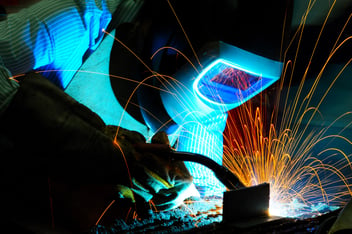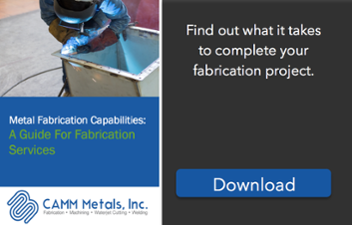 During the welding process, the weld metal and the adjacent base metal will expand and contract throughout the heating and cooling cycle. During these cycles, it’s inevitable that some distortion will occur due to the movement of the metal. However, it’s important to take steps to minimize this distortion whenever possible. Here are some tips to minimize welding distortion.
During the welding process, the weld metal and the adjacent base metal will expand and contract throughout the heating and cooling cycle. During these cycles, it’s inevitable that some distortion will occur due to the movement of the metal. However, it’s important to take steps to minimize this distortion whenever possible. Here are some tips to minimize welding distortion.
1. Size of Weld
It’s important to avoid overwelding. The bigger the weld, the greater the shrinkage that will occur. Ensuring that the weld has been correctly sized will minimize distortion and save weld metal and time.
2. Intermittent Welding
Intermittent welding, rather than continuous welds will minimize the amount of weld metal used. This will, in turn, minimize the distortion during the welding process.
3. Fewer Weld Passes
During the welding process, shrinkage will accumulate with every weld pass. Therefore, a fewer number of passes will result in less distortion. Try to perform a small number of big weld passes rather than a large number of small passes.
4. Welding Placement
It’s important to place welds near the neutral axis or center of the part. This placement will result in less leverage for shrinkage forces to pull plates out of alignment. Avoiding pulling the plates out of alignment will minimize the distortion of the product.
5. Balance Around the Neutral Axis
Balancing your welds around the neutral axis of the product and weld on both sides of the plate in order to offset one shrinkage force with another. This balance will minimize distortion, as the forces will counteract each other.
6. Backstep Welding Technique
Using the backstep welding technique involves generally welding left to right, while depositing each bead segment right to left. As each bead segment is placed, the heated edges expand, temporarily separating the plates. However, as the heat moves out, expansion along the edges brings the plates back together. Successive beads cause the plates to expand less and less throughout the process because of the restraint that the prior welds cause. This technique minimizes distortion as the welding process goes on.
7. Presetting Parts
Through a few trial welds at the beginning, you can determine the amount of preset required for prior welds. You can then use this information to preset parts before welding in order to make the shrinkage work for you. This control of shrinkage will minimize the distortion of your product.
8. Alternate Welding Sequence
A carefully planned welding sequence can help minimize distortion. During assembly, the structure will shrink in one place, counteracting the shrinkage in another. This counteraction will create a balance that will prevent distortion.
9. Clamping
Using clamps will lock parts into the desired position and hold them until the welding is finished. Although removing the clamps can cause minimal distortion, it will cause significantly less distortion than movement during welding.
10. Peening
Peening is the process of striking a product with the back part of a hammer. Peening the weld bead will stretch it and relieve stresses, minimizing distortion. However, it should be performed carefully and not executed on the final pass where it can cover a possible crack.
11. Thermal Stress Relief
Another technique to relieve stress in order to minimize distortion is thermal stress relief. This process involves controlled heating of the weldment to an elevated temperature followed by a controlled cooling. This control of temperature will reduce stresses pulling on the product.
12. Minimize Welding Time
The longer the welding process takes, the greater the chance for distortion. Minimizing your welding time is a good way to reduce welding distortion. Use of mechanized welding equipment will reduce the welding time and distortion.
13. Water-Cooled Jig
Using a water-cooled jig is an effective tool in minimizing distortion in sheet metal welding. The tool carries heat away from the welded components and circulates water through the tubes during welding. Clamps are also used in this process to minimize the distortion.
14. Strongback
A strongback is a tool used to control distortion during butt-welding of plates. Clips are welded to the edge of one plates, while wedges are driven under the clips to force the edges into alignment while holding them during welding. This tool can help reduce distortion in this specific welding process.
CAMM Metals | CT Welding Services
In order to ensure your welding comes with minimal distortion, call int he professionals! As a CT welding contractor, we specialize in MIG & TIG welding of Steel, Stainless Steel and Aluminum and use Pulsed welding machines to help control the heat put into a part, minimize distortion, and improve the quality of the parts we produce.
After the welding is complete, we offer many in-house services. These services include, weld inspection with dye penetrant, acid cleaning and polishing of stainless steel welds. Additionally, we are also able to weld and test watertight enclosures.For those customers who require certified welds, we can certify our welds to AWS D1.1 & AWS D1.6.



